Femia > Health Library > Pregnancy > Pregnancy health > How to spot the difference between single and twin pregnancy symptoms
How to spot the difference between single and twin pregnancy symptoms
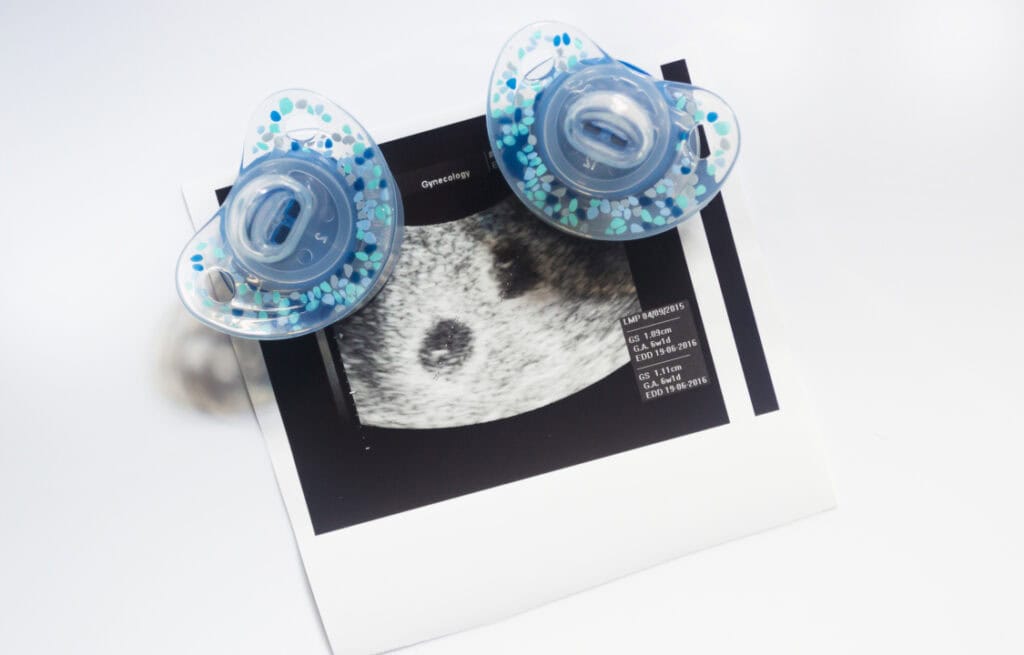
- Updated Feb 10, 2025
- Published
CRAFTED BY HUMAN
Crafted by human At Femia, we provide accurate and up-to-date information at every stage of your journey, from trying to conceive, pregnancy and postnatal support. All content is created by a real person based on in-depth research and own professional experience. Femia ensures that you will receive expert advice, strict accuracy and a personalized approach from our authors/medical experts. Learn more about our editorial policy.
FACT CHECKED
Fact checked At Femia Health, we maintain the highest standards of editorial excellence in delivering content focused on helping you conceive, guiding you through pregnancy, and supporting you postpartum. Explore our content review principles to learn how we ensure the accuracy and quality of our health and lifestyle tips for every stage of your journey.
Twin pregnancies are accompanied by the same set of early pregnancy signs. The primary difference between single and twin pregnancy symptoms is that expectant mothers of twins might experience more intense symptoms. The most noticeable signs are more severe fatigue, back pain, increased appetite, and more prominent nausea.
The twin birth rate in the US has gone from 18.9 per 1,000 births in 1980 to 31.2 in 2022, which is quite an increase. On the one hand, the growing twin rate might be associated with an increased quality and frequency of assisted reproductive technology, but the natural twin conception rate went up as well.
There are many factors that affect the chance of getting pregnant with multiples, including fertility treatment, maternal age, hereditary factors, etc. Often, women with a higher chance of having twins know this and may guess that they are pregnant with twins from early weeks. In any case, if you are an expectant mother, chances are that you and your partner want to know for sure whether you’re going through a single or twin pregnancy.
While twin pregnancy symptoms may seem similar to single-pregnancy ones, there might be some deviations in the symptoms’ intensity and patterns. In this guide, we’ll tell you all about the difference between single and twin pregnancy symptoms to help you confirm or refute your assumptions, manage your expectations, and prepare accordingly.
Early twin pregnancy symptoms
Common early pregnancy signs may include:
- Missed (or lighter) period;
- Nausea;
- Fatigue;
- Mood swings;
- Tender and sore breasts;
- Frequent urination;
- Changes in sense of smell and taste ;
- Unusual cravings.
The same range of symptoms is typical both for single and multiple gestations. The difference is in the varying levels of maternal hormones. Though twins often have lower placental and birth weights compared to single-fetus pregnancies, their total fetal-placental mass is larger. This is linked to increased levels of hormones, such as estrogens, progesterone, human chorionic gonadotropin (hCG), and others. These higher hormone levels might be linked to the more intense nature of all the aforementioned pregnancy symptoms.
A woman pregnant with multiples might face the same morning sickness, vomiting, and fatigue, but their manifestation might be more prominent. Additionally, you may notice earlier and more fast-paced weight gain. This is due to your body’s increased need to use resources to grow two fetuses. Using a pregnancy app can help you monitor your symptoms and provide insights into whether their intensity might indicate a twin pregnancy.
designed just for you
Personalized meal plans, symptom tracking, and more with the Femia
Difference between single and twin pregnancy symptoms week by week
First trimester: conception to 12 weeks
During the early weeks of pregnancy, you may not know that you’re pregnant yet. The first sign of pregnancy you might notice is when your next period doesn’t arrive or is noticeably lighter than usual. You might not notice any other symptoms yet, but tender or swollen breasts are common.
In weeks 5–12 you may experience a range of early pregnancy symptoms. Compared to carrying a single fetus, a twin pregnancy might be accompanied by more severe morning sickness and fatigue. Additional signs you may notice include a metallic taste in your mouth, new food likes and dislikes, a heightened sense of smell, bloating, dizziness, cramping, and others.
By the end of your first trimester, you may notice the first physical changes in your body—your weight may start changing a bit, your breasts may get larger, and your nipples may stick out more. The typical size of a fetus at week 12 is three inches (the size of a plum), which is barely noticeable in single pregnancies. However, a twin bump is more likely to show sooner, because you will have not one but two plum-sized babies in your belly.
👉Find out more: First trimester pregnancy diet: 1 to 3-month pregnancy diet chart and meal plans
Second trimester: 13–26 weeks
Entering the second trimester of your twin pregnancy, you will likely experience an increased appetite and start noticing a more rapid weight gain compared to moms-to-be with a single baby.
In single pregnancies, females on average gain 22 lbs to 28 lbs, with most weight gain happening after week 20. They also experience some appetite changes, but twin pregnancies tend to differ in intensity.
In twin pregnancies, women are carrying two babies and either one or two placentas, as well as more amniotic fluid. This means more fetal-placental weight and more individual weight gain.
Women carrying twins gain 4–6 pounds on average in the first trimester and add up to 1,5 pounds per week during the second and third trimesters. The total weight gain may be around 35 lbs to 45 lbs.
A more significant appetite compared to single pregnancies is explained by the fact that you need to eat not for two but for three of you. Your body will need more calories than if you were carrying a single baby. And, since you might also feel more tired during a twin pregnancy, you might need more nutrients, fluids, and vitamins to reduce fatigue and ensure a healthy developmental environment for your babies.
Other typical symptoms you may experience through weeks 13–26 include:
- Sleeping issues and fatigue;
- Cramps;
- Headaches;
- Nosebleeds;
- Bloating;
- Sore breasts;
- Swollen hands and feet;
- Leg cramps;
- Dizziness;
- Feeling hot;
- Frequent urination;
- Round ligament pain;
- Congestion;
- Heartburn.
Some mothers-to-be may also continue experiencing first-trimester symptoms like nausea and vomiting, and, once again, some or all symptoms you experience might be more intense.
By the end of the second trimester, your babies reach the size of a scallion each, and you may see noticeable weight gain and a prominent bump. Often, the fundal height in twin pregnancies is greater than gestational age, leading to a larger belly. Early fetal movement or movement in multiple areas is also common in twin pregnancies.
Third trimester: 27–40 weeks
Weeks 27–40 are the home stretch of your pregnancy, during which your babies are growing and developing at a rapid pace. Their size will change from a cucumber to a watermelon each by the final, 40th week.
As your babies and bump get to their maximum size, you will likely experience tangible physical discomfort greater than what singleton mothers experience. The symptoms may include swelling in the hands, legs, and feet. You may experience shortness of breath and back pain. It may become harder to sleep, walk, and perform other routine activities, and you might feel a more pronounced fatigue.
During the third trimester, you will likely experience occasional Braxton Hicks contractions, which prepare your body for labor. These are a natural part of every pregnancy. However, during twin pregnancy, you might have a greater number of Braxton Hicks because your body wants to prepare well.
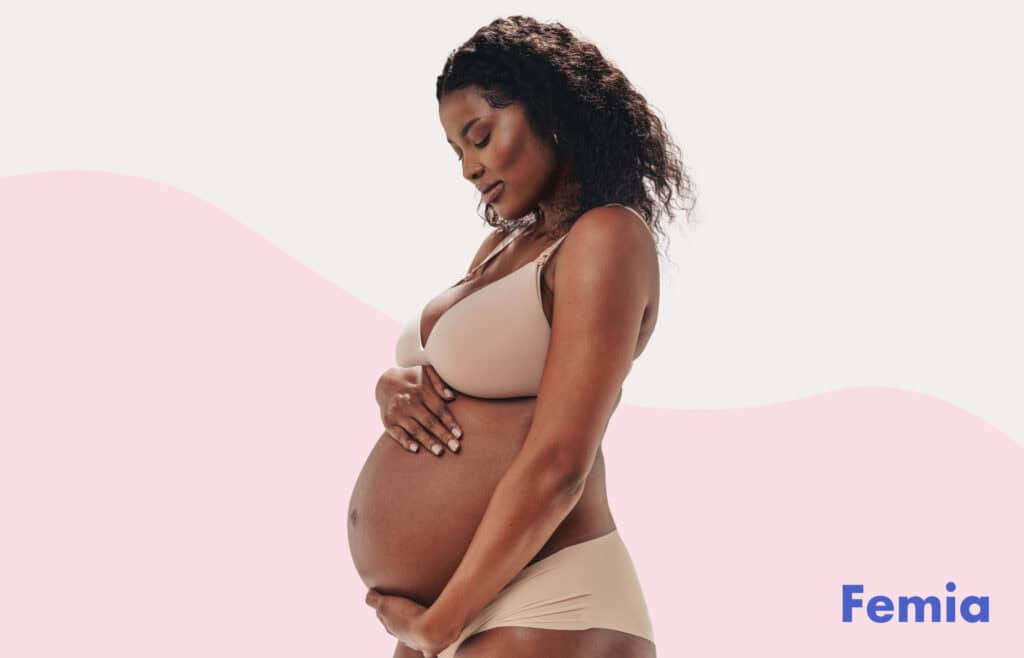
Managing twin pregnancy symptoms
Since the primary difference between single and twin pregnancy symptoms is their severity, it’s natural if you wonder how to manage your symptoms for a smoother and healthier twin pregnancy journey.
Here are a few tips you can consider to use:
- Plan regular prenatal check-ups. Doctors treating twin pregnancies have to observe two fetuses instead of one. You may want to plan more frequent doctor visits than during a single pregnancy to give your healthcare provider the opportunity to keep a close eye on both fetuses and ensure their healthy development.
- Find your methods of managing nausea. Consider eating small, frequent portions. Try choosing bland foods without strong smells or tastes that can cause vomiting. Also, consider trying other interventions, such as consuming ginger, chamomile, lemon oil, mint oil, vitamin B6, etc.
- Maintain mild physical activity. Regular, low-impact exercising is shown to improve mental wellness and release endorphins, which are natural painkillers. It can also help you strengthen your body and prepare for labor better. However, it’s important to opt for mild activity and avoid anything strenuous. Expectant mothers of twins often choose walking (64%), swimming (19%), home gymnastics (19%), exercise ball workouts (18%), etc.
- Get enough rest. To manage more prominent fatigue, you should make adequate sleep (7–8 hours per night) your top priority. Consider taking naps when feeling tired and establishing relaxing routines, such as journaling or meditation, before bed to improve your quality of sleep.
- Provide extra support for your back. To minimize the back pain caused by carrying twins, you can try practicing good posture, supporting the arches of your feet with low-heeled (but not flat) shoes, wearing abdominal support garments, and choosing good sleep positions.
Additionally, be sure to follow the individual recommendations of your healthcare provider.
👉Find out more: Twin pregnancy belly week by week: What to expect
Twin ultrasound vs. single ultrasound
While some symptoms may point to a twin pregnancy, an ultrasound can help you confirm that you are carrying multiple embryos as early weeks 6–10. Ultrasound assessment of fetal biometry, anatomy, Doppler velocimetry, and amniotic fluid volume is important for ensuring the healthy development of fetuses and identifying possible complications early on.
Here are a few distinctive features between single and twin pregnancy ultrasound:
- Ultrasound images. An ultrasound image of a single pregnancy would show one amniotic sac. This is a small, thin-walled sac that looks like a circle on the ultrasound screen. It’s filled with amniotic fluid and surrounds the fetus during pregnancy to protect it. In a twin pregnancy, an ultrasound image will show two distinct gestational sacs, one per twin, and it will detect two heartbeats, as well.
- Monitoring frequency. Ultrasound has revolutionized the way we manage multiple pregnancies and potential complications with them. When carrying twins, expected mothers typically need more frequent monitoring compared to women pregnant with a single baby. Frequent ultrasounds, scheduled based on your healthcare provider’s recommendations, are important for assessing the fetuses’ growth and development and detecting and addressing possible issues timely.
designed just for you
Personalized meal plans, symptom tracking, and more with the Femia
Twin vs single pregnancy belly
Now that you know the difference between single and twin pregnancy symptoms week by week and the difference between ultrasounds, let’s talk about the physical differences in carrying a single baby or twins.
There are three things to keep in mind when comparing twin belly vs single belly:
- Early differences. A twin belly often shows earlier. This is due to the rapid growth of the uterus needed to facilitate two babies.
- Belly size and shape. Twin bellies are generally larger, as they carry two fetuses. They may also take different shapes, depending on the babies’ positioning.
- Physical discomfort. Carrying twins implies gaining more weight yourself and carrying more weight inside your belly. This can cause more prominent physical discomfort, including leg swelling, back pain, etc.
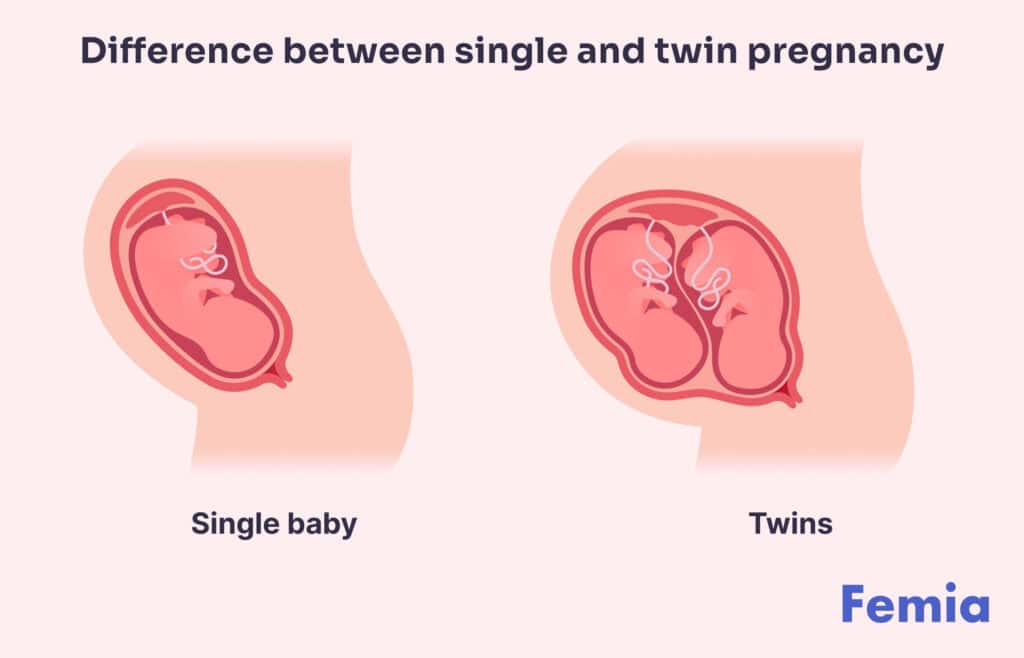
Questions from the Femia community
Can intense early pregnancy symptoms indicate a twin pregnancy?
Early pregnancy symptoms, such as nausea, vomiting, and fatigue are similar in single and twin pregnancies. A higher intensity of these symptoms may indicate that you are carrying twins. However, the only sure way to confirm a twin pregnancy is to have an ultrasound assessment—it can show multiple embryos as early as 6–10 weeks.
What should I expect in terms of weight gain with twins?
Expectant mothers of twins typically gain more weight than women carrying a single baby. The average overall weight gain is around 35–45 lbs, compared to the 22–28 lbs typically gained during a single pregnancy.
👉Find out more: Understanding weight loss during pregnancy
How can I track my weight gain?
Tracking your weight gain during pregnancy involves regular check-ins to ensure you're within the recommended range based on your pre-pregnancy BMI and individual needs. Using a pregnancy weight gain calculator can help you monitor healthy weight gain and adjust your diet or activity level as needed. Additionally, your healthcare provider will track your progress during routine prenatal visits and provide guidance to support your health and your baby’s development.
How does prenatal care differ between single and twin pregnancies?
Typically, twin pregnancies involve more sophisticated prenatal care with more frequent doctor visits, ultrasounds, and additional tests. This increased monitoring is needed for efficient assessment of the development and health of two babies, as well as for early detection and addressing of potential complications.
Are there any special dietary requirements for twin pregnancies?
Two growing babies use much more of the body’s resources. That’s why a twin pregnancy typically requires more calories, nutrients, and vitamins, such as folic acid and iron. It’s important to consult with your healthcare provider or a nutritionist to develop an individual diet plan that supports your and your babies’ health.
👉Find out more: First trimester pregnancy diet: 1 to 3-month pregnancy diet chart and meal plans
The bottom line
The difference between single and twin pregnancy symptoms is that twin pregnancies are typically accompanied by more severe common symptoms, including nausea, vomiting, fatigue, swelling, breast tenderness, and others. The more intense nature of symptoms is natural and explained by higher levels of hormones, as well as physical differences between single and twin pregnancies, such as a larger mass of fetuses.
Twin pregnancies might be more demanding. However, they can be manageable with proper care and support.
References
- Jenny Yang. “U.S. twin birth rate 1980-2022.” Statista, 6, May, 2024. https://www.statista.com/statistics/276017/us-twin-birth-rate/.
- “Signs and symptoms of pregnancy.” The National Health Service (NHS). https://www.nhs.uk/pregnancy/trying-for-a-baby/signs-and-symptoms-of-pregnancy/.
- Souza MA, de Lourdes Brizot M, Biancolin SE, Schultz R, de Carvalho MHB, Francisco RPV, Zugaib M. “Placental weight and birth weight to placental weight ratio in monochorionic and dichorionic growth-restricted and non-growth-restricted twins.” Clinics (Sao Paulo), May, 2017. https://www.ncbi.nlm.nih.gov/pmc/articles/PMC5439100/.
- Seravalli V, Strambi N, Di Tommaso M. “Hormones and Multiple Pregnancy.” In: Petraglia F, Di Tommaso M, Mecacci F, eds. “Hormones and Pregnancy: Basic Science and Clinical Implications.” Cambridge University Press, 2022. https://www.cambridge.org/core/books/abs/hormones-and-pregnancy/hormones-and-multiple-pregnancy/29078983B0045098549DA8227CA7A0A8.
- “Fetal Development.” Cleveland Clinic. https://my.clevelandclinic.org/health/articles/7247-fetal-development-stages-of-growth.
- “Weight gain in pregnancy.” The National Health Service (NHS). https://www.nhs.uk/pregnancy/related-conditions/common-symptoms/weight-gain/#:~:text=Weight%20gain%20in%20pregnancy%20varies,after%20your%20baby%20is%20born.
- “Weight Gain With Twins.” American Pregnancy Association. https://americanpregnancy.org/healthy-pregnancy/multiples/weight-gain-with-multiples/.
- “Are There Any Differences Between Single and Twin Pregnancy Symptoms?” OB/GYN Associates of Idaho Falls, 3, Jan. 2024. https://obgynif.com/difference-between-single-and-twin-pregnancy-symptoms/.
- “Twin Pregnancy.” Cleveland Clinic, 1, Jun. 2022. https://my.clevelandclinic.org/health/articles/23158-twin-pregnancy.
- “Braxton Hicks Contractions.” Cleveland Clinic, 10, May, 2022. https://my.clevelandclinic.org/health/symptoms/22965-braxton-hicks.
- Matthews A, Haas DM, O’Mathúna DP, Dowswell T, Doyle M. “Interventions for nausea and vomiting in early pregnancy.” Cochrane Database Syst Rev, 21, Mar. 2014. https://pubmed.ncbi.nlm.nih.gov/24659261/.
- Kwiatkowska K, Kosińska-Kaczyńska K, Walasik I, Osińska A, Szymusik I. “Physical Activity Patterns of Women with a Twin Pregnancy-A Cross-Sectional Study.” Int J Environ Res Public Health, 21, Jul. 2021. https://www.ncbi.nlm.nih.gov/pmc/articles/PMC8345556/.
- Mayo Clinic Staff. “Back pain during pregnancy: 7 tips for relief.” Mayo Clinic, 12, Mar. 2024. https://www.mayoclinic.org/healthy-lifestyle/pregnancy-week-by-week/in-depth/pregnancy/art-20046080.
- A. Khalil, M. Rodgers, A. Baschat, A. Bhide, E. Gratacos, K. Hecher, M. D. Kilby, L. Lewi, K. H. Nicolaides, D. Oepkes, N. Raine-Fenning, K. Reed, L. J. Salomon, A. Sotiriadis, B. Thilaganathan, Y. Ville. “ISUOG Practice Guidelines: role of ultrasound in twin pregnancy.” Obstetrics and Gynaecology, 18, Nov. 2015. https://obgyn.onlinelibrary.wiley.com/doi/full/10.1002/uog.15821#:~:text=Ultrasound%20assessment%20of%20fetal%20biometry,fetal%20growth%20restriction%20(FGR).
- Townsend R, Khalil A. “Ultrasound surveillance in twin pregnancy: An update for practitioners.” Ultrasound, Nov. 2018. https://www.ncbi.nlm.nih.gov/pmc/articles/PMC6243450/.
- Chasen ST, Spiro SJ, Kalish RB, Chervenak FA. “Changes in fetal presentation in twin pregnancies.” J Matern Fetal Neonatal Med, Jan. 2005. https://pubmed.ncbi.nlm.nih.gov/15804786/.

Experiencing third trimester nausea? Learn what causes it, how to find relief, and when to consult a doctor. Discover tips to stop feeling sick in late pregnancy.
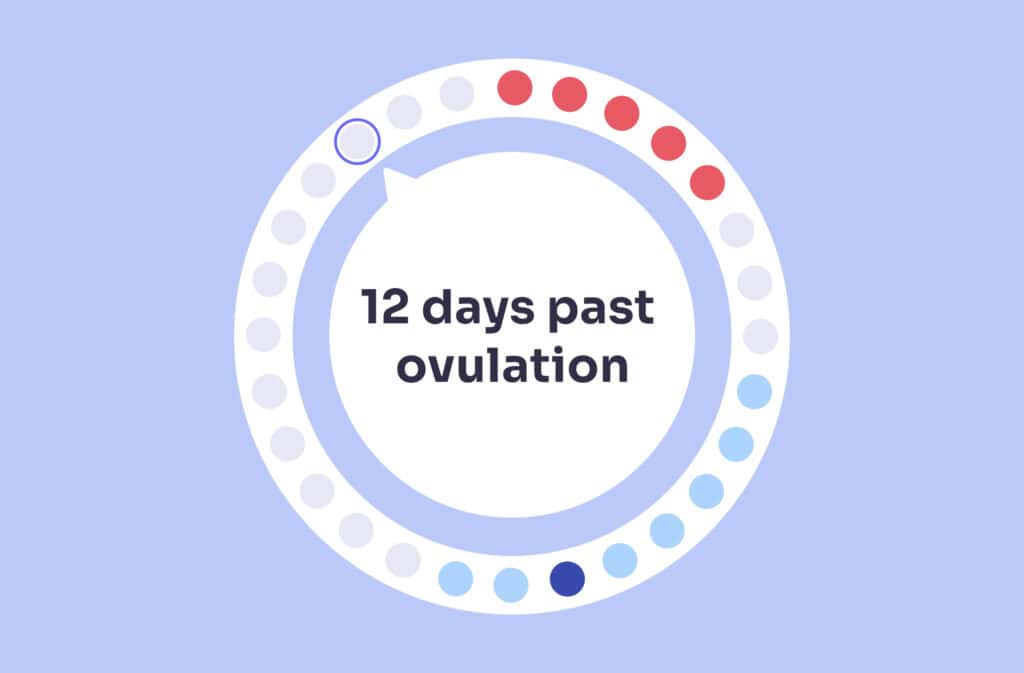
Learn about the symptoms at 12 days past ovulation (12 DPO), including signs of early pregnancy, and discover the best time to confirm with a pregnancy test. Expert advice from Femia.
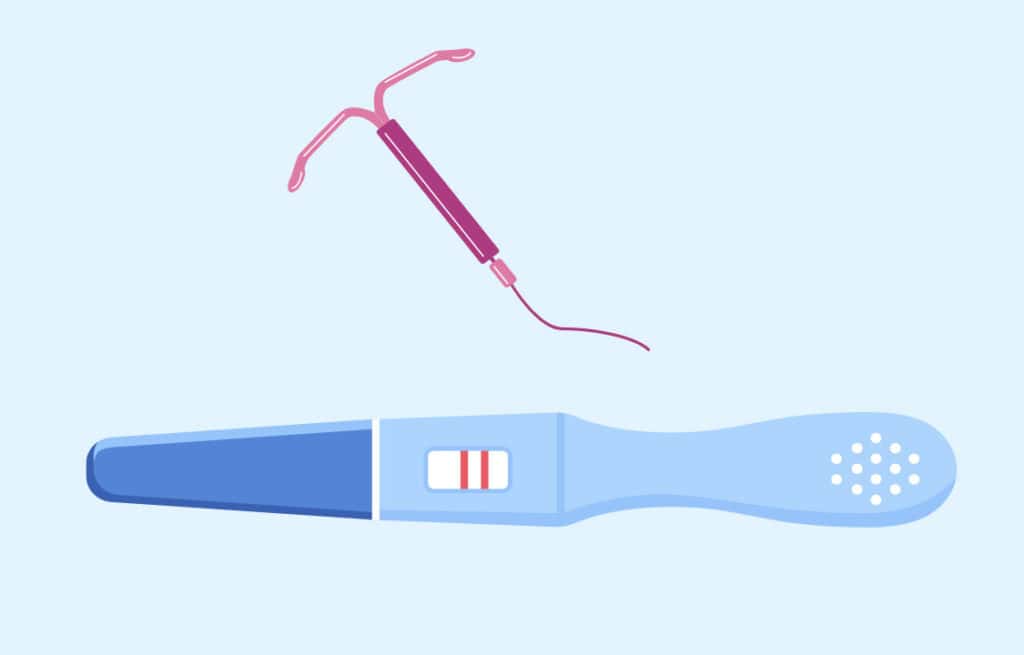
Discover how long it takes to get pregnant after IUD removal, factors affecting pregnancy after IUD removal, and potential reasons for delay. Learn tips for boosting fertility post-IUD removal.

